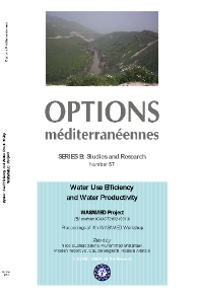| Article précédent | p. 59-61 | Article suivant |
On the conservative behavior of biomass water productivity
The focus of this note is biomass water productivity (WPb), also referred to as biomass water use efficiency (WUEb) in the literature. In developing the theoretical background and the appropriate framework for analyzing the constancy of WPb, we follow a stepwise scaling-up approach, from leaf to whole crop field, in the analysis of the two basic processes involved, water transpiration (T) and net carbon assimilation (A), and its conversion to biomass. An important implication of normalizing biomass water productivity is that it allows the comparison of water productivity data across the globe on equal footing, after accounting for differences due to variations in evaporative demand of the climate, and in atmospheric carbon dioxide concentration when applicable. Such comparisons will reveal more definitively the intrinsic properties of the crop or the management practices that alter such productivity. Most importantly, normalized WPb will provide a head start in knowing the WPb values at a new location or new time period when CO2 concentration is different, whether in the future or in the past. This offers an invaluable tool for modelling purposes, providing an effective way of extrapolating WPb values between different locations and seasons.
- [ Afficher ]
- [ Télécharger ]
- [ Exporter la citation ]
Vous pouvez télécharger la citation au format :
- [ Imprimer ]
-
Mots-clés
BIOMASSE, EFFICACITE, PHOTOSYNTHESE, PRODUCTIVITE, TRANSPIRATION, UTILISATION DE L'EAUCiter cet article
Steduto P., Hsiao T.C., Fereres E. On the conservative behavior of biomass water productivity. In : Lamaddalena N. (ed.), Shatanawi M. (ed.), Todorovic M. (ed.), Bogliotti C. (ed.), Albrizio R. (ed.). Water use efficiency and water productivity: WASAMED project. Bari : CIHEAM, 2007. p. 59-61. (Options Méditerranéennes : Série B. Etudes et Recherches; n. 57). 4. WASAMED (WAter SAving in MEDiterranean agriculture) Workshop, 2005/09/30-2005/10/04, Amman (Jordan). http://om.ciheam.org/om/pdf/b57/00800777.pdf



